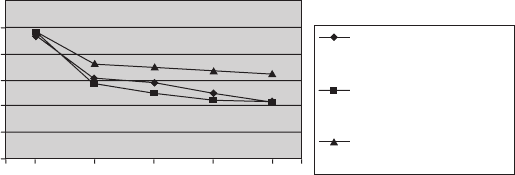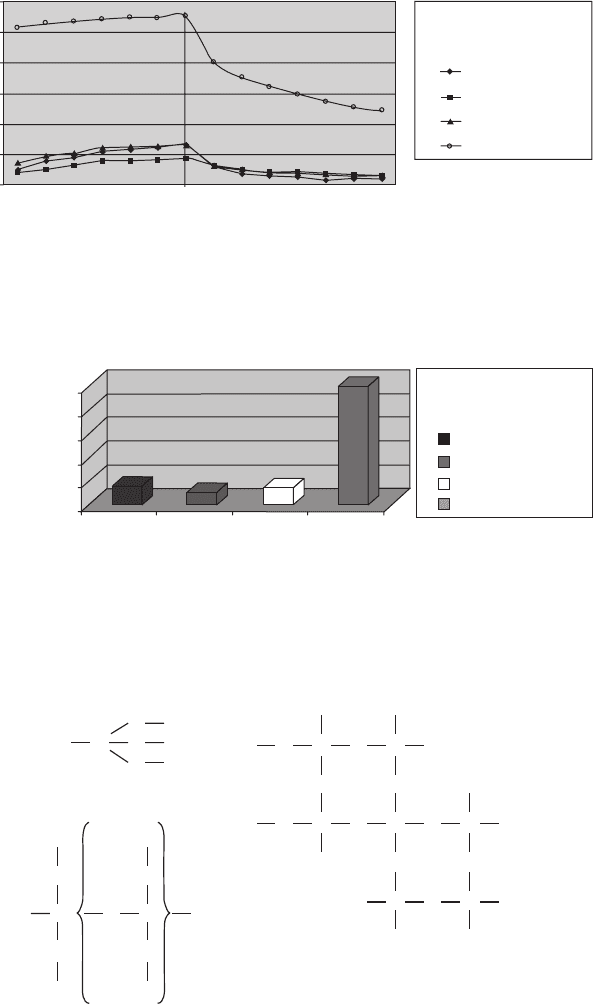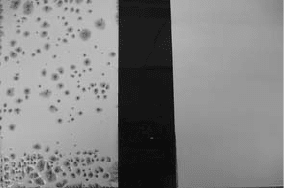Khanna A.S. (Ed.) High-Performance Organic Coatings: Selection, application and evaluation
Подождите немного. Документ загружается.


236 High-performance organic coatings
resistance.
12.6.3 High heat resistant coatings
Polysiloxanes themselves can be heat resistant up to 300°C depending on
resistance up to 650°C can be achieved. How does that work? At tempera-
tures above 160–180°C all siloxanes release their organic groups, mainly
methyl or phenyl as we have seen before. Other organic groups will be
released faster and already at lower temperatures. This decomposition of
the Si–C bond is a very slow process at temperatures below 300°C (it may
perature gets into the range of 400°C. At that temperature it is just a
question of minutes or a few hours until all organic groups are released.
Particularly in the presence of oxygen, the Si–C bond will be replaced by
Si–O–Si. Contrary to the above siloxane bond (recall that we speak about
siloxane when we have the Si–O–Si bond and organic groups attached to
the Si), we now get a silicate, similar to the structure of quartz. During the
decomposition of the organic groups, we get very reactive groups that are
able not just to form the silicate but also to a certain extent to react with
ceous iron oxide and mica. This combination of decomposed polysiloxane,
thickness is limited. Depending on the kind of resin, the kind of substrate
in the case of one-layer systems and 80 μm in the case of two-layer
systems.
100
80
60
40
20
0
0 6 12 18 24
Exposure time (months)
Gloss retention (%)
at 60° angle
Straight polyester,
crosslinked with iso-
cyanate
Straight polyester,
crosslinked with
melamin
30% silicone
12.4 Weather resistance with outdoor exposure in Florida.
modified polyester
significantly improved gloss retention, which indicates the good weather
the specific composition. With coatings based on polysiloxane resins, heat
last years until completed) and is significantly accelerated when the tem-
inorganic pigments and/or fillers.The best reactions with fillers and the best
i.e. reactive silicate and the inorganic fillers, forms films that are heat resis-
tant to 650°C. Because of differences in the coefficient of temperature
expansion of the metal substrate and the silicate-based coating, the film
and the substrate preparation, the film thickness should not exceed 30 μm
heat resistance will be achieved with aluminium pigments (flakes), mica-
© 2008, Woodhead Publishing Limited

Polysiloxane coatings for corrosion protection 237
Principally, all siloxane resins, particularly those used for high heat resis-
tant coatings, are heat-curing resins, i.e. they cure at a temperature in excess
of 180°C only. Nevertheless, quite often low temperature drying or drying
in environmental conditions is required. This can be achieved by the choice
of a polysiloxane resin that dries at ambient temperature either physically
or if a small amount (3–5% on solid resin) of organic resins, such as ketone
resins or cellulose derivates, e.g. cellulose aceto butyrates (CAB), is added
to the paint formulation. The standard polysiloxane resins are from the
composition T/D = approx. 1 : 1 and phenyl/methyl = 1 : 1 on a molar basis
– see Section 12.2 above.
Tables 12.4 and 12.5 show two guideline formulations with which heat
resistance to 650°C can be achieved. These coatings are resistant not only
shock. Long-term anti-corrosion properties at high heat can be achieved if
a polysiloxane-based zinc dust primer is used too – see Table 12.6.
Table 12.4 Heat resistant polysiloxane coating; top coat micaceous iron oxide;
long-term thermal stability approx. 650°C
% by weight
Polysiloxane resin solution, 50% 26.1
White spirit –
Xylene 7.5
1-Methoxy propyl acetate-2 7.4
Bentone 38, 7.5% 6.6
Micaceous iron oxide 52.4
100.0
Composition: binder 13.1
pigments 51.2
additives 0.5
solvents 35.2
100.0
Application
Application method: spraying
Drying
are only attained after exposure to high temperature, i.e. through normal
operation of plant.
Application viscosity
Flow time, DIN 53 211, 23°C: approx. 20 s (DIN 4 cup)
Dry film thickness: approx. 15 μm
The coating dries at room temperature to form tack-free films resistant to the
knocks of assembly/installation. The final resistance properties and hardness
to such high heat but also against fluctuations of temperature and thermal
© 2008, Woodhead Publishing Limited

238 High-performance organic coatings
Table 12.5 Heat resistant polysiloxane coating; aluminium bronze top coats;
long-term thermal stability approx. 600°C
% by weight
Polysiloxane resin solution, 50% 16.6
White spirit –
Xylene 23.4
1-Methoxy propyl acetate-2 23.4
Bentone 38, 7.5% 3.2
Aluminium bronze 33.4
100.0
Composition: binder 8.3
pigments 21.7
additives 0.2
solvents 69.8
100.0
Application
Application method: spraying
Drying
are only attained after exposure to high temperature, i.e. through normal
operation of plant.
Application viscosity
Flow time, DIN 53 211, 23°C: approx. 20 s (DIN 4 cup)
12.7 Concrete protection
Concrete is perhaps one of the most extensively used construction materi-
skyscrapers of every kind are made from concrete. Its importance is steadily
increasing and it seems to be an almost unlimited construction material.
steel bars is incorporated into concrete, making a reinforced concrete
or direct tension than a plain concrete section with the same dimensions
would be. The alkaline chemical environment provided by portland cement
more resistant to corrosion than it would be in neutral or acidic
conditions.
Although well known for its long durability, concrete is subject to erosion,
with constant attack from humidity and chloride ion penetration. Not only
Dry film thickness: approx. 15 μm
The primer dries at room temperature to form tack-free films resistant to the
knocks of assembly/installation. The final resistance properties and hardness
als. Highways, tunnels, bridges, airport runways, hotels, office buildings and
To get sufficient compressive and tensile strength, reinforcement such as
section. This is much more efficient in carrying tensile forces due to bending
causes a passivating film to form on the surface of steel, making it much
© 2008, Woodhead Publishing Limited

Polysiloxane coatings for corrosion protection 239
does this have a destructive impact on the concrete itself, but even more
important is the effect it has on the reinforcement steel used to improve
the tension of the concrete structure. When rebar corrodes, the rust expands,
cracking the concrete and unbonding the rebar from the concrete.
The water in the pores of the cement is normally alkaline; this alkaline
environment is one in which the steel is passive and does not corrode.
Carbon dioxide from the air reacts with the alkali in the cement and makes
the pore water more acidic. This acidity, in combination with humidity, will
lead to corrosion of the rebar. Chloride ions will further promote the cor-
rosion of steel rebar.
All these destructive reactions require water. Keeping the concrete dry
is an important goal of concrete protection and maintenance. Water-
repellent protection that leaves the concrete surface breathable (vapour
permeable) and reduces (or suppresses) the chloride ion penetration is
required. Broadly used for that purpose are bitumen coatings. However,
bitumen coatings are reported to have limited durability and after a while
Table 12.6 Heat resistant polysiloxane primer; zinc dust primer; long-term
thermal stability approx. 500°C
% by weight
Polysiloxane solution, 50% 18.6
Xylene 1.4
Bentone 38, 7.5% 11.0
Zinc dust 69.0
100.0
Composition: binder 9.3
additives 0.8
pigments 69.0
solvent 20.9
100.0
Technical data
Pigmentation level, calculated on solid binder: 740%
Storage stability: >3 months
Application
Application method: usually by spraying, though also by brushing or rolling,
max. 30 μm per coat (two-coat system)
Drying
are only attained after exposure to high temperature, i.e. through normal
operation of plant.
providing the maximum film thickness is not exceeded.
Dry film thickness: max. 50 μm (single-coat system)
The primer dries at room temperature to form tack-free films resistant to the
knocks of assembly/installation. The final resistance properties and hardness
© 2008, Woodhead Publishing Limited
240 High-performance organic coatings
the above-mentioned destructive impact will start. Modern alternatives are
siloxanes and the most modern are water-based siloxane emulsions. Tests
for roadwork applications (such as tunnels, bridges, etc.) carried out by
independent and authorized institutes in Germany and Sweden have proven
ing to the National Cooperative Highway Research Program Report 244-II
The main subjects of the tests have been:
• Water absorption
• Drying (vapour permeability)
• Chloride ion absorption.
For this test the concrete formulation used was:
• Type I Portland Cement 439 parts
• Eau Claire Sand 1500 parts
• Eau Claire Coarse Aggregates 1758 parts
• Water 225 parts
A siloxane emulsion which is supplied with 60% content of active ingredi-
ent was diluted with water in the ratio 1 : 3, i.e. the content of active ingredi-
ent of the applied material was 15%. The application rate was 400 square
feet per gallon = approximately 5 m
2
/litre.
The diluted siloxane emulsion was applied on the concrete after one day
of drying of the concrete as well as after 5 days and 21 days of the concrete
drying (curing). After 7 days of the curing of the impregnant, the prepared
specimen was exposed to aqueous 15% NaCl solution and the water intake
was measured frequently up to 21 days. Then the specimens was stored in
dry conditions and the water evaporation (drying) was also measured fre-
quently up to 21 days. Parallel to the water absorption, the intake of chlo-
ride ions after 21 days of exposure to the salt bath was analysed. Of course,
the test was done in comparison with an untreated reference. Details of the
test report are shown in Figs 12.5 and 12.6.
Water repellence, breathability and reduction of chloride ions could be
proved impressively, thus the rebar will be protected from corrosion, and
The above discussion of siloxane emulsions as a more modern solution
serves to introduce some ideas about the durability of a siloxane impregna-
tion. One can subdivide the silicones or silanes used in the hydrophobation
of constructions or construction materials into three classes (Fig. 12.7),
essentially:
• Monomeric alkyl alkoxy silanes
• Oligomeric alkyl alkoxy siloxanes
• Polymeric siloxanes (methyl silicone resins).
their efficiency. The most recent tests for US highway applications accord-
(Report 244) confirmed the European test results.
freeze–thaw resistance will also be improved significantly.
© 2008, Woodhead Publishing Limited

Polysiloxane coatings for corrosion protection 241
3.00
2.50
2.00
1.50
1.00
0.50
0.00
0 5 10 15 21 5 10 15 21
Water intake phase
(days of water exposure)
Drying phase
(days of drying)
1
day
5
days
21
days
Control
Application rate:
200
sq ft/gallon
Days of concrete drying
before application of the
impregnant
Weight difference (%)
12.5 Siloxane emulsion, 15% active ingredients, water intake and
evaporation (test according to US National Cooperative Highway
Research Program report 244, performed by CTL, Chicago).
100
80
60
40
20
0
Days of concrete drying
before application of
the impregnant
1
day
5
days
21
days
Control
Application rate:
200
sq ft/gallon
Control1521
Days of drying before coating
Ion content
(%)
16 % 11 %
15 %
100 %
12.6 Siloxane emulsion, 15% active ingredients; reduction in chloride
ion content (%) after 21 days’ exposure to salt solution (test according
to US National Cooperative Highway Research Program report 244,
performed by CTL, Chicago).
Polysiloxane
(silicone resin)
Siloxane, oligomer
Silane, monomer
R, R*, R** = alky1
O
Si SiO
O
ORO
Si SiO
R
Si OO
Si RSi OO
OO
OO
R*
R*
R*
R* R*
SiSi O R
n = 3–5
R
RO
RR** OSi
RO
12.7 Structure principles of silanes and siloxanes.
© 2008, Woodhead Publishing Limited

242 High-performance organic coatings
It is common for all three types that they build in the end use after curing
a stable, three-dimensional, resin-like network. The chemical similarity to
the silicate components of building materials leads to stable and durable
bonds with most mineral substrates. At the same time, the alkyl groups
orient to the exterior (air) side and protect the surface like little umbrellas
against penetration of humidity (see Fig.12.8).
Depending on their chemical structure (see Table 12.7) one must distin-
guish the mode of action or the site of attachment of the siloxanes. While
molecular weight silanes and oligomeric siloxanes penetrate into the avail-
able pores, i.e. the low molecular weight products are subject to capillary
absorption. Embedded in the pores and chemically reacted to the building
material, they reduce the capillary absorption of water, the well-known
sucking effect of all capillaries. Therefore, low molecular weight silanes and
the appearance of the building material remains visually unchanged. The
The siloxane backbone reacts with silicate from the substrate
and forms a durable connection, while the alkyl groups
protect the substrate like umbrellas
Si
Si
CH3
CH3
3HC
O
O
Si
O
O
CH3
12.8 Principle of water repellency.
Table 12.7 Properties of silane, siloxane and polysiloxane
Silane Siloxane Polysiloxane
Structure monomeric oligomeric polymeric
Penetration; capillar activity very deep deep poor
Application form (% active
ingredient)
20–100 1–10 3–8
approx. 40% approx.
80%
100%
Optical effect to the
substrate
none none to
some
darkening,
‘wet-look’
effect
Water vapour permeability high high medium
Beading poor poor
Efficiency
significant
polysiloxane creates a film particularly at the substrate surface, the low
oligomer silanes have almost no influence upon the substrate surface, and
© 2008, Woodhead Publishing Limited
Polysiloxane coatings for corrosion protection 243
a visual change, i.e. a dark, wet-looking surface.
Oligomeric siloxane emulsions quite effectively penetrate into the pores
of the concrete and do not change the surface appearance. Because they
do not remain on the surface of the substrates, the emulsions are recoatable
and can be used as a primer, e.g. for coatings and plaster. The strong chemi-
12.8 Siloxanes as paint additives
As said above (Section 12.6), siloxanes have low surface energy, i.e. are
surface active materials. Particularly the linear structures (D based only),
attached, are very surface active. In Section 12.5.2. we learned that just this
class of products can cause cratering and recoatability problems. These
issues are closely related to the molecular weight or the chain length of the
siloxanes – the higher the molecular weight the more severe the problem.
How can we overcome this issue? On the one hand we have a surface active
and levelling, while on the other hand it causes craters and adhesion prob-
lems due to extreme incompatibility. The solution is to organically modify
Various properties can be controlled by the siloxane : polyether ratio, but
also by the type of polyether – ethylene oxide and/or propylene oxide,
or on the end, plays an important role in achieving the intended properties,
the chain lengths of the siloxane and the polyether. The fact that this strat-
egy is very successful shows that there is no automotive top coat that does
not contain a small amount (approximately 0.1% of the total paint formula-
There are two main ways to modify the siloxane with polyether, the fol-
lowing showing them schematically:
1. condensation of an OH-functional siloxane with a butanol-initiated
polyether:
−−− − ⎯ →⎯⎯⎯
−−−
O Si OH + C H O (EO) (PO)
OSiO
49
catalyst
e.g. amine
XY
−−(EO) (PO) +C H OH
49XY
2. Addition of allyl-initiated polyether to a hydrogen-functional siloxane:
−−− − − ⎯ →⎯⎯⎯
−−−
O Si OH + C H=CH CH (EO) (PO)
OSi(CH
22
Pt catalyst
XY
223
)(EO)(PO) −
XY
polymeric siloxanes, on the other hand, form a surface film which leads to
cal bond of the product leads to a very efficient long-term durability.
the polydimethyl siloxane. The modifiers most often used are polyethers.
random or block structures. The place of the modification, on the chain side
too. Finally, of course, a very significant factor for the overall behaviour is
tion) of this kind of modified siloxane.
which we call polysiloxane fluids, with just methyl groups as organic groups
material which might be able to improve substrate wetting as well as flow
© 2008, Woodhead Publishing Limited

244 High-performance organic coatings
Both reactions can be done on the side or on the end of the siloxane chain,
depending on where you functionalize the siloxane.
As said, these materials are surface active products and interact with the
various surfaces:
• coating surface ⇔ air
• substrate ⇔ coating
These surfaces are obvious, but within the paint formulation there are also
solvents (or water) and various other additives, one can easily imagine that
if a surface active material is added. If the uncountable number of paint
formulations are considered, it will become impossible to predict the behav-
iour. So the right choice of siloxane paint additive has to be related to a
some general rules that might be considered:
• Generally, siloxane-polyethers with Si–O–C bonds are not stable against
hydrolysis, and not recommended for water-based systems (reaction 1
above).
• Those with Si–C bond are stable against hydrolysis (reaction 2 above).
• Linear siloxane-polyethers mainly result in increased slip and mar resis-
tance, as well as defoaming.
• Low molecular weight grades have more surfactant properties; they
improve substrate and pigment wetting.
Figure 12.9 shows a water-based polyester polyurethane coating applied
on uncleaned steel. The left panel lacks a siloxane paint additive, while the
right panel contains 0.1% of a siloxane-polyether of structure 2 with low
doubt that substrate wetting is improved.
12.9 Water-based polyester polyurethane coating applied on
uncleaned steel.
various surfaces such as pigment ⇔ binder, and filler ⇔ binder; adding
there so many surfaces that it is difficult to foresee what would happen
specific test. Independently of the above-mentioned difficulties, there are
molecular weight, where the siloxane chain is side-modified. There is no
• Side-modified types improve flow and levelling.
© 2008, Woodhead Publishing Limited
Polysiloxane coatings for corrosion protection 245
12.9 How do siloxane paint additives work?
There are mainly three effects resulting from the use of the siloxane-
polyether paint additives:
1. Reduction of surface tension
2.
3. Concentration of the products on top of the coating.
Before we come to discuss these effects in more detail, recall that the silox-
anes are surface active materials. Siloxanes have a surface tension of
approximately 20 mN m
−1
with surface tensions of approximately 21–25 mN m
−1
.
12.9.1 Reduction of surface tension
The addition of approximately 0.1% of these products to paint formulations
reduces the surface tension of wet paints from approximately 30–35 mN m
−1
to a level of 25–28 mN m
−1
. The exact level depends on the structure and
molecular weight of the siloxane-polyether and the total paint formulation.
It is well known that the wetting of surfaces with liquids depends on the
surface tensions – the surface tension of the liquid must be lower than that
of the substrate. The lower the surface tension of the liquid (paint), the
better the wetting.
12.9.2 Surfactant structure of the organically
where A represents the siloxane and B the EO-polyether, we get a product
(siloxane). These hydrophilic and oleophilic sides interact respectively with
the corresponding hydrophilic or oleophilic parts in the paint formulation
and/or between paint and substrate. Thus substrate and/or pigment wetting
is improved.
12.9.3 Concentration of the products on top of the coating
Another well-known surface tension-related effect is that in liquids the
parts with lower surface tension tend to migrate to the top of the liquid
(liquid/air surface) and to spread there. During drying of liquid paints
(water or solvent based) the diluent evaporates from the top, increasing the
Surfactant structure of the organically modified siloxanes
. The polyether modification results in products
modified siloxanes
Particularly if the polyether in the modified siloxane is ethylene oxide based
and if there is a linear AB structure, i.e. an end-modified siloxane-polyether
with a significantly hydrophilic side (polyether) and an oleophilic side
surface tension there. The lower parts of the wet film now have lower
© 2008, Woodhead Publishing Limited
